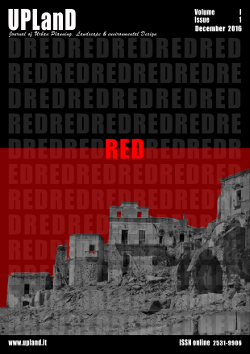Seismic and energy retrofitting of residential buildings: a simulation-based approach
Main Article Content
Abstract
The topic of the high seismic vulnerability of housing stock in Italy is back again at the center of political, economic, social and scientific-technical debate following the seismic crisis that struck Marche, Umbria and Lazio regions in 2016. These events have once again raised the need for a massive retrofitting program at National and Regional level, addressing the majority of the existing building stock, realized for 60% prior to the adoption of the first seismic code (Law 64/74), in a territory characterized north to south by high levels of seismic hazard. In recent years, different kinds of tools have been implemented to allow the simulation of natural hazards’ impacts on the built environment and to support strategic choices both in the field of emergency management and resilience-based urban design and planning. Nevertheless, an integrated set of instruments for a quantitatively informed decision support is still missing.
Within EU-FP7 CRISMA project, an integrated DSS (Decision Support System) application has been developed, with a set of tools and functionalities addressing the main aspects involved in the decision-making processes for natural hazards preparedness and response.
Downloads
Article Details

This work is licensed under a Creative Commons Attribution-NonCommercial-NoDerivatives 4.0 International License.
Authors who publish with this journal agree to the following terms:- Authors retain copyright and grant the journal right of first publication with the work simultaneously licensed under a Creative Commons Attribution License that allows others to share the work with an acknowledgement of the work's authorship and initial publication in this journal.
- Authors are able to enter into separate, additional contractual arrangements for the non-exclusive distribution of the journal's published version of the work (e.g., post it to an institutional repository or publish it in a book), with an acknowledgement of its initial publication in this journal.
- Authors are permitted and encouraged to post their work online (e.g., in institutional repositories or on their website) prior to and during the submission process, as it can lead to productive exchanges, as well as earlier and greater citation of published work (See The Effect of Open Access).
References
MMC - Multihazard Mitigation Council (2005). Natural Hazard Mitigation Saves: an independent study to assess the future savings from mitigation activities. Washington D.C.: National Institute of Building Sciences.
Polese, M., Zuccaro, G., Nardone, S., La Rosa, S., Marcolini, M., Coulet, C., Griselle, M., Daou, M.P., Pilli-Sihvola, K., Aubrecht, C., Steinnocher, K., Huber, H., Taveter, K., Vassiljev, S., Tuomaala, P., Piira, K., Molarius, R., Almeida, M., Ribeiro, L., & Viegas, C. (2014). Time-Dependent Vulnerability for Systems at Risk (V2), Deliverable D43.2 of the Integrated project “CRISMA”, Project no. FP7/2007-2013 n. 284552. European Commission.
Zuccaro, G., Leone, M.F., del Cogliano, D., & Sgroi, A. (2013). Economic impact of explosive volcanic eruptions: a simulation-based assessment model applied to Campania Region volcanoes. Journal of Volcanology and Geothermal Research, 266, 1-15.
Zuccaro G., & Cacace F. (2010). Seismic impact scenarios in the volcanic areas in Campania. In Mazzolani, F. Urban Habitat Constructions under Catastrophic Events. London, UK: Taylor & Francis Group.
Zuccaro, G., & Cacace, F. (2011). Seismic Casualty Evaluation: The Italian Model, an Application to the L’Aquila 2009 Event. In Spence, R., So, E., Scawthorn, C. (Eds.) Human Casualties in Earthquakes. Advances in Natural and Technological Hazards Research, Volume 29, (pp.171-184). Dordrecht, NL: Springer Science Business Media B.V.
Zuccaro, G., Polese, M., Nardone, S., Leone, M., Guarino, S., Garcia-Aristizabal, A., Cacace, F., Sileno, N., Aubrecht, C., Steinnocher, K., Almeida, M., Viegas, D., Ribeiro, L. M., Pinto, C., Schlobinski, S., & Scholl, M. (2015). Demonstrator of Pilot D. Deliverable D55.1 of the Integrated project “CRISMA”, Project no. FP7/2007-2013 n. 284552. European Commission.
Zuccaro, G., Cacace, F., Spence, R.J.S., & Baxter, P.J. (2008). Impact of explosive eruption scenarios at Vesuvius, Journal of Volcanology and Geothermal Research, 178, 416-453.
Zuccaro, G., & Leone, M.F. (2014). La mitigazione del rischio vulcanico come opportunità per una città ecologica e resiliente / The mitigation of volcanic risk as opportunity for an ecological and resilient city. TECHNE Journal of Technology for Architecture and Environment, 7, 101-107.

